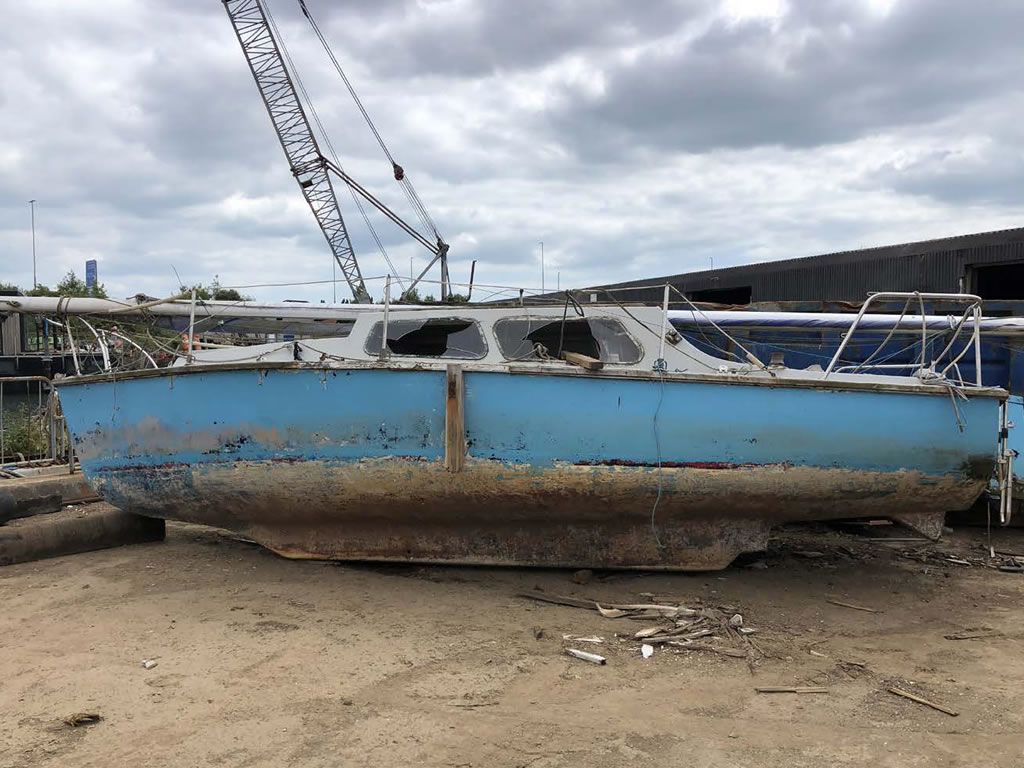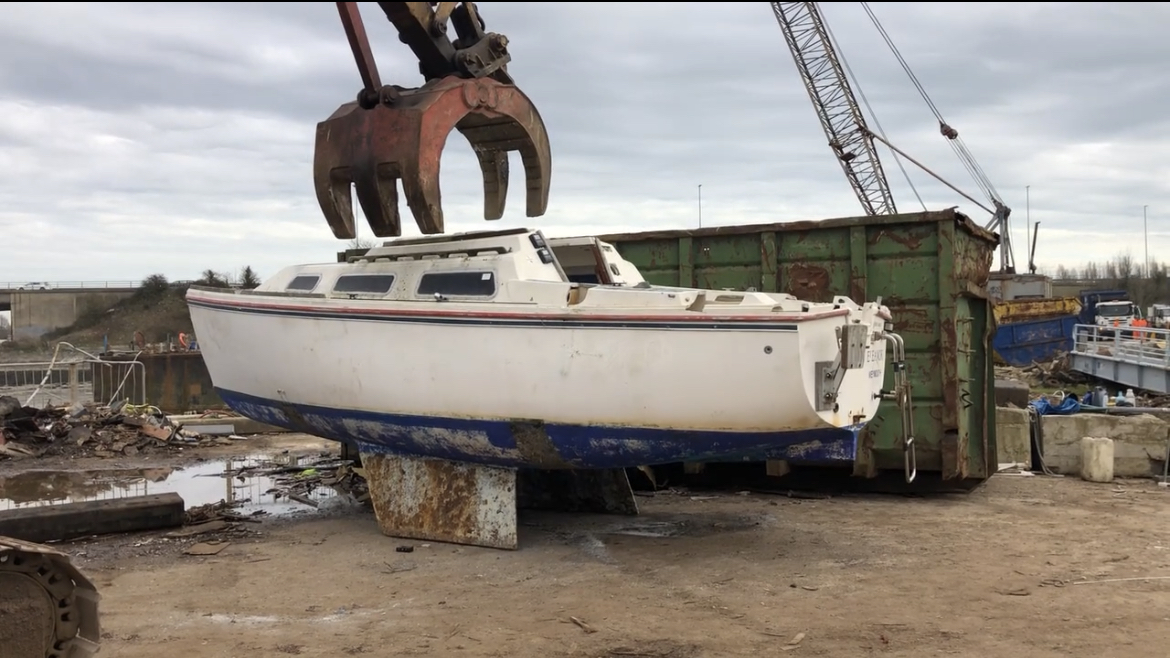Boat Recycling Article

At Boatbreakers we always enjoy reading articles written about the subject of Boat Recycling. Recently we came across two articles on the NauticExpo e-magazine site that we found to be an interesting read.
Boat Recycling Faces Heavy Weather
(Nautic Expo, e-Magazine)
Article written by Celia Sampol
France is one of the few countries with regulations governing the dismantling and recycling of recreational vessels. But with economic and psychological hurdles, and problems reusing fiberglass, the obstacles are numerous. We spoke to Benoît Ribeil, project officer at APER, the French network overseeing the dismantling of boats up to 24 meters.
NE e-mag: Today, there are no global or EU regulations governing boat recycling. France finally passed a law in 2015. Why has the problem been ignored for so long?
Benoît Ribeil: The tragedy of the planned obsolescence of electrical and electronic devices we face every day doesn’t exist for recreational craft. These vessels can last for 40 or 50 years if they’re well maintained and if certain conditions are met. We’re now at the end of the useful life of boats built in the 1970s, when composites—fiberglass and resin—first entered recreational boating and the sector developed. That’s why the question of recycling has arisen only recently.
NE e-mag: What’s hindering boat recycling?
Benoît Ribeil: Several things. First, there’s a significant sentimental aspect. A boat has a history rich with many memories. It’s not like a lightbulb, a telephone or even a car. You don’t just toss it aside.
Then there’s the learning curve. Until now, no one thought about how to dismantle or recycle a boat, even the first generation of buyers, because, as I said, these are products that last 40 or 50 years. That means that today there’s a real need to address the psychological aspects and explain why it’s important to recycle boats the same way we recycle other things.
Last, there are economic and regulatory aspects. Judging the end of a boat’s useful life is subjective. There’s no technical inspection like the one for automobiles. In addition, the law doesn’t compel a boat owner to dismantle the vessel, though this is changing in France. Since dismantling costs money, the owner prefers to stick the boat in the back yard, sink it, burn it, abandon it or sell it cheaply to get rid of the problem. That’s today’s mindset.
NE e-mag: How much does it cost to dismantle a boat?
Benoît Ribeil: We estimate that the average cost for an eight-meter recreational vessel is about 1000 euros, payable entirely by the owner. It’s not a lot compared to a year’s operating expenses, but combined with the sentimental factor and the lack of mandatory recycling, it’s hard to convince boat owners to dismantle their craft.NE e-mag: What are the steps in boat dismantling?
Benoît Ribeil: The first step is to take stock. The dismantling company evaluates the boat’s location and the lifting and transportation requirements for everything on the boat—air conditioning, refrigerators, pyrotechnic materials, etc. Then there’s logistics—lifting and transporting the boat to the dismantling site. Once there, the company carefully disassembles and sorts the different elements. The boat winds up in pieces stored in crates.The other possibility is more industrial, requiring a much larger investment. The boat will be put into an enormous crusher. Then, machines will sort the debris, separating ferrous from non-ferrous materials, for example. The result is the same. You end up with small piles of sorted waste.
The final step is to make some use of the materials. The aluminum goes to a suitable waste stream, the ferrous metal to a foundry and the wood to a sawmill. That leaves the composites—fiberglass and resin.
The average cost for an eight-meter vessel is about 1000 euros.
NE e-mag: So, what do you do with fiberglass-resin composites?
Benoît Ribeil: They could be buried in specific sites. It’s not an ideal solution because such waste will take millions of years to disappear. But it’s legal and, unfortunately, necessary.Another possibility is to transform it into a solid recovered fuel by mixing it with other types of waste. It’s then used to fire cement plants in place of fossil fuel. There’s also research and development underway with the goal of converting it into a new raw material.
NE e-mag: Can it be used to build new boats?
Benoît Ribeil: No, because the composites are degraded. After 50 years of use, they don’t have the same properties as when they were new. And after crushing the fibers are much shorter and don’t retain their initial properties. That means they can’t be used to build new boats. On the other hand, they might be suitable for certain elements aboard the boat that don’t require specific mechanical properties, for example the shower tray, cupboard doors, shelves or a mattress support.
We already have the techniques for that, but there are parameters to manage. These are primarily logistic and technical, because we’re talking about low volumes. The nautical sector consumes only 4% of composites. We won’t find solutions by ourselves, but will have to work with other industries.
Today’s primary challenge is to reuse and recycle fiberglass.
In addition, our worn out composites are not just fiberglass and resin. There’s also paint of unknown composition, wood, plastics, etc. That makes it difficult to characterize vessel composites.
We’re also facing economic constraints. New fiberglass is extremely cheap. That leaves us offering recycled fiberglass that is more expensive because of the all the operations we’ve been discussing, and whose properties are inferior to those of the new product. Try selling that to a businessperson. Today, the numbers don’t add up. But that’s part of tomorrow’s challenges for the nautical industry.
NE e-mag: Could biocomposites be a solution?
Benoît Ribeil: We shouldn’t play one against the other. We need to move forward on both fronts because the two sectors are totally different. Today, biocomposites are at the experimental stage. We’re not ready for industrial-scale production and there’s a lack of real-life data. Moreover, the use of biocomposites will only deliver results 40 or 50 years from now, if they last that long. Thus, we’re forced to find solutions for the stock of existing material and all the composites used in boats being manufactured today. They currently represent 98% of boat manufacturing. That means that today’s primary challenge is to reuse and recycle fiberglass.NE e-mag: It’s not really your field, but what about recycling large vessels like trawlers?
Benoît Ribeil: Big boats are different because they’re made of different materials—steel hulls, for example. The shipowner considering dismantling will look at scrap metal prices and the laws of the country where the work might be done. The social and environmental constraints differ from country to country. It’s in the owner’s interest to do the work in a country with minimal restrictions. But things are changing. European directives now force owners to dismantle their vessels in Europe using government-authorized companies.
Written By: Luke Edney
Luke completed a journalism degree in Brighton University and fortunately for us uses this in his communications, Facebook posts, Tweets and emails to tell all our enquirers and followers what we are up to. Without Luke we would be lost, he runs the office, keeps us organised and is like a terrier and never lets a tricky boat disposal job go un-photographed or Tweeted about.
He also manages all of our enquiries passing them to whoever in the team is the best suited to deal with it. We are teaching Luke how to drive a motorboat or sail a yacht so while he’s learning we suggest you keep out of the Solent!
When he’s not at work he’s a massive football fan (his Dad used to play for Portsmouth FC years ago) and seems to know everything there is to know about any player, anywhere. Next time you ring and he answers, think of a tricky football trivia question and ask him
Date Published: June 29, 2017
Last Modified: June 28, 2022
Related Articles
- Published On: November 8th, 2023
Why should you scrap your boat? It's not something boat owners ever really have to think about. However those owners who have older boats or ones that they just can't sell certainly do.
- Published On: July 26th, 2017
Abandoned boats are a growing global problem. Boatbreakers focus our efforts on the UK and Europe but across the Atlantic there is a similar problem occurring. At Boatbreakers we often get enquiries from American boat owners who are looking to dispose of their end of life vessel in a responsible manner.
- Published On: January 21st, 2021
The Boatbreakers team were recently contacted by Nigel Robinson who was writing a piece for The Cruising Association about end of life boat disposal. As always our team were more than happy to discuss the many issue we face in [...]
- Published On: February 14th, 2023
Where is the nearest boat disposal yard near me? That will be the question most owners will ask when they have a problem boat to shift.




